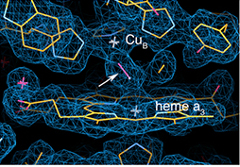
Unraveling the structure of proteins is a key to understanding how they function in the body or the environment. One of the major applications of RIKEN's advanced SACLA x-ray free electron (XFEL) laser located in Harima, Japan, is the analysis of protein structures using incredibly brilliant but short pulses of laser light. X-rays have been used for a century as a powerful way of analyzing crystallized proteins, but with a major downside: the rays can destroy the crystal structure while analyzing it, as they generate reactive oxygen species from the water molecules in the crystal. These molecules then rapidly react with the protein molecules, causing damage. Ironically, the measurement device ends up modifying the very target it is trying to analyze.
XFEL lasers like SACLA provide a way to overcome this, as they can generate extremely short pulses of light, so a "snapshot" of diffraction patterns can be taken before the damage has occurred. This presents problems of its own, however, since difficult techniques are typically needed to reconstruct the protein structure from a large number of diffraction patterns.
Now, in research published in Nature Methods, a team of scientists led by Hideo Ago of the RIKEN SPring-8 Center have developed a new method for analyzing protein structure before its destruction. Using the SACLA laser, they illuminated a large single crystal of cytochrome c oxidase, a protein involved in the respiratory cycle which is particularly vulnerable to x-ray damage. Bursts of laser light lasting just ten femtoseconds—or a hundred trillionth of a second—were focused on the sample as it was gradually rotated, and the diffraction patterns were analyzed and transformed into a 3D image of the molecule without any damage from the x-rays.
This new method holds promise for the analysis of metalloproteins, for example, which are highly sensitive to x-ray damage, and could promote a better understanding of how proteins function on short time scales.
